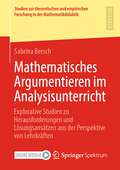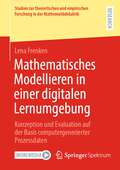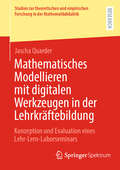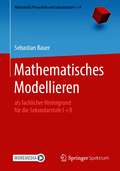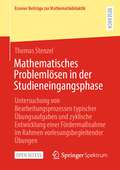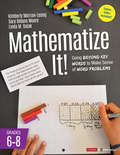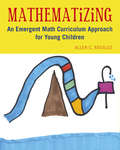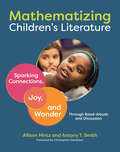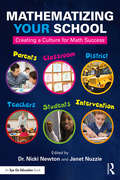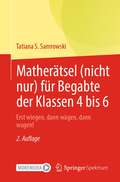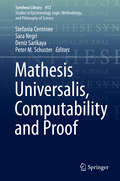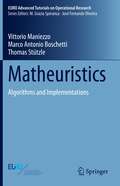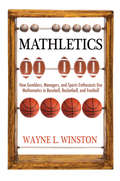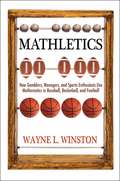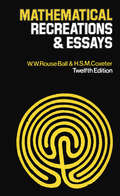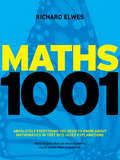- Table View
- List View
Mathematisches Argumentieren im Analysisunterricht: Explorative Studien zu Herausforderungen und Lösungsansätzen aus der Perspektive von Lehrkräften (Studien zur theoretischen und empirischen Forschung in der Mathematikdidaktik)
by Sabrina BerschSabrina Bersch untersucht in zwei aufeinander aufbauenden qualitativen Studien das mathematische Argumentieren im Analysisunterricht aus der Perspektive von Lehrkräften. Zunächst werden die Begriffe Argumentieren, Begründen und Beweisen geklärt und in einem Modell zueinander in Beziehung gesetzt. Das mathematische Argumentieren wird dabei im weiten Sinne als Oberbegriff verstanden. Die erste Interviewstudie thematisiert unter anderem die aktuelle Situation des mathematischen Argumentierens im Analysisunterricht. Es zeigt sich insbesondere, dass die Heterogenität von Lerngruppen sowie sprachliche Schwierigkeiten von Schülerinnen und Schülern zentrale Herausforderungen für Lehrkräfte sind. Als Reaktion darauf werden weitere theoretische Grundlagen geklärt und eine differenzierende, aufgabenbasierte Lernumgebung mit sprachförderlichen Elementen zum Argumentieren mit ganzrationalen Funktionen ausgearbeitet. Hierfür werden verschiedene Aufgaben, Lösungsbeispiele und Formulierungshilfen entwickelt. Der unterrichtliche Einsatz dieser Lernumgebung durch Lehrkräfte wird mit einer anschließenden, zweiten Studie evaluiert.
Mathematisches Argumentieren im Übergang von der Arithmetik zur Algebra: Eine qualitative Studie von Lehrkrafthandlungen im Mathematikunterricht (Perspektiven der Mathematikdidaktik)
by Fiene BredowArgumentieren ist wichtig für das Lernen von Mathematik. Lehrkräfte tragen entscheidend dazu bei, ob und wie Argumentationen im Mathematikunterricht gelingen. Welche Rolle die Lehrkraft beim mathematischen Argumentieren im Übergang von der Arithmetik zur Algebra spielt, arbeitet Fiene Bredow in dieser Studie heraus. Dazu werden Unterrichtssituationen im Übergang von der Arithmetik zur Algebra erhoben und die stattfindenden Argumentationsprozesse und die hervorgebrachten mathematischen Argumente mit einem Fokus auf die Lehrkraft analysiert. Angelehnt an Conner et al. (2014) werden Unterstützungshandlungen von Lehrkräften kodiert und weitere Lehrkrafthandlungen induktiv rekonstruiert. Ein Kategoriensystem zu Lehrkrafthandlungen bei Argumentationen im Mathematikunterricht wird entwickelt. Als ein entscheidender fachlicher Aspekt im Übergang von der Arithmetik zur Algebra wird die Prozess-Produkt Dualität von mathematischen Objekten beim Argumentieren betrachtet und herausgearbeitet, wie Lehrkräfte die Deutungen ihrer Schüler:innen adressieren. Diese Studie zeigt, dass mathematische Argumentationsprozesse vielschichtig, komplex und auch fragil sind.
Mathematisches Modellieren in einer digitalen Lernumgebung: Konzeption und Evaluation auf der Basis computergenerierter Prozessdaten (Studien zur theoretischen und empirischen Forschung in der Mathematikdidaktik)
by Lena FrenkenLena Frenken untersucht in der Studie, welche im Rahmen des eigens initiierten Projekts Modi – Modellieren digital durchgeführt wurde, die Auswirkungen einer digitalen Lernumgebung zum mathematischen Modellieren mit metakognitiven Wissenselementen. Dabei stehen die Kompetenzentwicklung des mathematischen Modellierens sowie die Entwicklung des metakognitiven Wissens über mathematisches Modellieren im Fokus der Analysen. Mithilfe der Item Response Theory werden Personenfähigkeitsparameter ermittelt, die hinzugezogen werden können, um bivariate sowie multivariate Analysen durchzuführen. Außerdem werden explorative Regressionsanalysen beschrieben, mit deren Hilfe Prädiktoren für die Entwicklung der Teilkompetenzen mit aus den computergenerierten Prozessdaten extrahierten Variablen ermittelt werden. Es zeigt sich, dass für den Kompetenzerwerb selbstregulative sowie sprachliche Fähigkeiten und die Sicherheit im Umgang mit einer eingebetteten Dynamischen Geometriesoftware äußerst relevant sind. Daraus können Konsequenzen für weitere Forschungsprojekte sowie für die Schulpraxis hergeleitet werden, die von hoher Relevanz sind.
Mathematisches Modellieren mit digitalen Werkzeugen in der Lehrkräftebildung: Konzeption und Evaluation eines Lehr-Lern-Laborseminars (Studien zur theoretischen und empirischen Forschung in der Mathematikdidaktik)
by Jascha QuarderDie vorliegende Arbeit stellt die Konzeption und Evaluation des Lehr-Lern-Laborseminars MiRA-digital zum mathematischen Modellieren mit digitalen Werkzeugen dar. MiRA-digital wird als fachdidaktisches Seminar im Rahmen der ersten Phase der Lehrkräftebildung an der Universität Münster angeboten. Das Seminar zeichnet sich durch eine Theorie-Praxis-Verzahnung sowie komplexitätsreduzierte Rahmenbedingungen aus und zielt darauf ab, Mathematiklehramtsstudierende bereichsspezifisch (d.h. für den Unterrichtsbereich des mathematischen Modellierens mit digitalen Werkzeugen) zu professionalisieren. Die Evaluation des Seminars bezieht sich auf die Wirksamkeit dieser Professionalisierung und erfolgt mittels einer quantitativen quasi-experimentellen Interventionsstudie im Prä-Post-Design. Mit Fokus auf das bereichsspezifische Aufgabenwissen und das bereichsspezifische adaptive Interventionswissen wurden Daten von N = 165 Studierenden über vier Semester erhoben und kumulativ ausgewertet. Die Ergebnisse zeigen, dass die Entwicklung der beiden bereichsspezifischen Wissensarten positiv und signifikant durch die Teilnahme am Seminar MiRA-digital beeinflusst wird. In einem Lehr-Lern-Laborseminar zum mathematischen Modellieren ohne digitale Werkzeuge und einer Kontrollgruppe konnte hingegen keine umfassende signifikante Entwicklung dieser Wissensarten festgestellt werden. Damit wird die Wirksamkeit des Lehr-Lern-Laborseminars MiRA-digital bestätigt.
Mathematisches Modellieren: als fachlicher Hintergrund für die Sekundarstufe I +II (Mathematik Primarstufe und Sekundarstufe I + II)
by Sebastian BauerDas Buch richtet sich an Studierende und Lehrende des Lehramts der Sekundarstufe sowie an Lehrerinnen und Lehrer der Sekundarstufe. Es baut auf Grundkenntnissen in der Analysis und der Linearen Algebra, wie sie gewöhnlich in den ersten Semestern des Studiengangs erworben werden, auf und knüpft an typische Modellierungsaufgaben aus der Schulpraxis an. Hierbei werden besonders bedeutende, historisch interessante oder ästhetisch ansprechende mathematische Modelle unterschiedlicher Bezugswissenschaften zusammen mit der dafür benötigten mathematischen Theorie entwickelt und dargestellt. Dabei erfolgt die nötige Theorieentwicklung immer in enger Verzahnung mit den betrachteten mathematischen Modellen. Typische Vorgehensweisen des Modellierens, wie Dimensionsanalysen, Vereinfachung durch Linearisierung, Isolierung verschiedener Effekte und Vernachlässigung kleiner Effekte, werden im Verlauf der Darstellung immer wieder aufgegriffen. Auf diese Weise ermöglicht das Werk Lehrkräften einen fachlich „höheren Standpunkt“ zu den schulischen Möglichkeiten und Anforderungen des Mathematischen Modellierens.
Mathematisches Problemlösen in der Studieneingangsphase: Untersuchung von Bearbeitungsprozessen typischer Übungsaufgaben und zyklische Entwicklung einer Fördermaßnahme im Rahmen vorlesungsbegleitender Übungen (Essener Beiträge zur Mathematikdidaktik)
by Thomas StenzelDieses Open-Access-Buch beschreibt die theoriebasierte Entwicklung einer semesterbegleitenden Maßnahme zur Förderung der Problemlösekompetenz von Studienanfänger:innen der Fachmathematik und des gymnasialen Lehramts, sowie die zyklische Modifikation dieser Maßnahme im Sinne der Entwicklungsforschung. Begleitend dazu wurden, mit dem Ziel, grundlegende Erkenntnisse zum studentischen Problemlösen zu gewinnen, systematische Beobachtungen von Bearbeitungsprozessen zu typischen Übungsaufgaben durchgeführt. Hierbei hat sich insbesondere die Rolle des Vorwissens als entscheidender Faktor herausgestellt.
Mathematize It! [Grades 3-5]: Going Beyond Key Words to Make Sense of Word Problems, Grades 3-5 (Corwin Mathematics Series)
by Linda M. Gojak Sara Delano Moore Kimberly Morrow-Leong"The list of math books to truly synthesize what we know so far and what we need to know is a very short and exclusive list. Well, you can confidently add Mathematize It to this collection. Written by three of the most respected math educators today, the book zeros in on that often poorly traveled journey between the question and answer in problem solving. Mathematize It will be your go-to resource to install the mathematical play revolution in elementary classes everywhere!" Suni Singh Author of Pi of Life: the Hidden Happiness of Mathematics and Math Recess: Playful Learning in an Age of Disruption Help students reveal the math behind the words "I don’t get what I’m supposed to do!" This is a common refrain from students when asked to solve word problems. Solving problems is about more than computation. Students must understand the mathematics of a situation to know what computation will lead to an appropriate solution. Many students often pluck numbers from the problem and plug them into an equation using the first operation they can think of (or the last one they practiced). Students also tend to choose an operation by solely relying on key words that they believe will help them arrive at an answer, which without careful consideration of what the problem is actually asking of them. Mathematize It! Going Beyond Key Words to Make Sense of Word Problems, Grades 3-5 shares a reasoning approach that helps students dig into the problem to uncover the underlying mathematics, deeply consider the problem’s context, and employ strong operation sense to solve it. Through the process of mathematizing, the authors provide an explanation of a consistent method—and specific instructional strategies—to take the initial focus off specific numbers and computations and put it on the actions and relationships expressed in the problem. Sure to enhance teachers’ own operation sense, this user-friendly resource for Grades 3–5 • Offers a systematic mathematizing process for students to use when solving word problems • Gives practice opportunities and dozens of problems to leverage in the classroom • Provides specific examples of questions and explorations for all four operations (addition, subtraction, multiplication, and division) with whole numbers, fractions, and decimals • Demonstrates the use of concrete manipulatives to model problems with dozens of short videos • Includes end-of-chapter activities and reflection questions How can you help your students understand what is happening mathematically when solving word problems? Mathematize it!
Mathematize It! [Grades 3-5]: Going Beyond Key Words to Make Sense of Word Problems, Grades 3-5 (Corwin Mathematics Series)
by Linda M. Gojak Sara Delano Moore Kimberly Morrow-Leong"The list of math books to truly synthesize what we know so far and what we need to know is a very short and exclusive list. Well, you can confidently add Mathematize It to this collection. Written by three of the most respected math educators today, the book zeros in on that often poorly traveled journey between the question and answer in problem solving. Mathematize It will be your go-to resource to install the mathematical play revolution in elementary classes everywhere!" Suni Singh Author of Pi of Life: the Hidden Happiness of Mathematics and Math Recess: Playful Learning in an Age of Disruption Help students reveal the math behind the words "I don’t get what I’m supposed to do!" This is a common refrain from students when asked to solve word problems. Solving problems is about more than computation. Students must understand the mathematics of a situation to know what computation will lead to an appropriate solution. Many students often pluck numbers from the problem and plug them into an equation using the first operation they can think of (or the last one they practiced). Students also tend to choose an operation by solely relying on key words that they believe will help them arrive at an answer, which without careful consideration of what the problem is actually asking of them. Mathematize It! Going Beyond Key Words to Make Sense of Word Problems, Grades 3-5 shares a reasoning approach that helps students dig into the problem to uncover the underlying mathematics, deeply consider the problem’s context, and employ strong operation sense to solve it. Through the process of mathematizing, the authors provide an explanation of a consistent method—and specific instructional strategies—to take the initial focus off specific numbers and computations and put it on the actions and relationships expressed in the problem. Sure to enhance teachers’ own operation sense, this user-friendly resource for Grades 3–5 • Offers a systematic mathematizing process for students to use when solving word problems • Gives practice opportunities and dozens of problems to leverage in the classroom • Provides specific examples of questions and explorations for all four operations (addition, subtraction, multiplication, and division) with whole numbers, fractions, and decimals • Demonstrates the use of concrete manipulatives to model problems with dozens of short videos • Includes end-of-chapter activities and reflection questions How can you help your students understand what is happening mathematically when solving word problems? Mathematize it!
Mathematize It! [Grades 6-8]: Going Beyond Key Words to Make Sense of Word Problems, Grades 6-8 (Corwin Mathematics Series)
by Linda M. Gojak Sara Delano Moore Kimberly Morrow-LeongHelp students reveal the math behind the words "I don’t get what I’m supposed to do!" This is a common refrain from students when asked to solve word problems. Solving problems is about more than computation. Students must understand the mathematics of a situation to know what computation will lead to an appropriate solution. Many students often pluck numbers from the problem and plug them into an equation using the first operation they can think of (or the last one they practiced). Students also tend to choose an operation by solely relying on key words that they believe will help them arrive at an answer, without careful consideration of what the problem is actually asking of them. Mathematize It! Going Beyond Key Words to Make Sense of Word Problems, Grades 6–8 shares a reasoning approach that helps students dig into the problem to uncover the underlying mathematics, deeply consider the problem’s context, and employ strong operation sense to solve it. Through the process of mathematizing, the authors provide an explanation of a consistent method—and specific instructional strategies—to take the initial focus off specific numbers and computations and put it on the actions and relationships expressed in the problem. Sure to enhance teachers’ own operation sense, this user-friendly resource for Grades 6–8: · Offers a systematic mathematizing process for students to use when solving word problems · Gives practice opportunities and dozens of problems to leverage in the classroom · Provides specific examples of questions and explorations for multiplication and division, fractions and decimals, as well as operations with rational numbers · Demonstrates the use of visual representations to model problems with dozens of short videos · Includes end-of-chapter activities and reflection questions How can you help your students understand what is happening mathematically when solving word problems? Mathematize it!
Mathematize It! [Grades 6-8]: Going Beyond Key Words to Make Sense of Word Problems, Grades 6-8 (Corwin Mathematics Series)
by Linda M. Gojak Sara Delano Moore Kimberly Morrow-LeongHelp students reveal the math behind the words "I don’t get what I’m supposed to do!" This is a common refrain from students when asked to solve word problems. Solving problems is about more than computation. Students must understand the mathematics of a situation to know what computation will lead to an appropriate solution. Many students often pluck numbers from the problem and plug them into an equation using the first operation they can think of (or the last one they practiced). Students also tend to choose an operation by solely relying on key words that they believe will help them arrive at an answer, without careful consideration of what the problem is actually asking of them. Mathematize It! Going Beyond Key Words to Make Sense of Word Problems, Grades 6–8 shares a reasoning approach that helps students dig into the problem to uncover the underlying mathematics, deeply consider the problem’s context, and employ strong operation sense to solve it. Through the process of mathematizing, the authors provide an explanation of a consistent method—and specific instructional strategies—to take the initial focus off specific numbers and computations and put it on the actions and relationships expressed in the problem. Sure to enhance teachers’ own operation sense, this user-friendly resource for Grades 6–8: · Offers a systematic mathematizing process for students to use when solving word problems · Gives practice opportunities and dozens of problems to leverage in the classroom · Provides specific examples of questions and explorations for multiplication and division, fractions and decimals, as well as operations with rational numbers · Demonstrates the use of visual representations to model problems with dozens of short videos · Includes end-of-chapter activities and reflection questions How can you help your students understand what is happening mathematically when solving word problems? Mathematize it!
Mathematize It! [Grades K-2]: Going Beyond Key Words to Make Sense of Word Problems, Grades K-2 (Corwin Mathematics Series)
by Linda M. Gojak Sara Delano Moore Kimberly Morrow-Leong"This book is a must-have for anyone who has faced the challenge of teaching problem solving. The ideas to be learned are supported with a noticeably rich collection of classroom-ready problems, examples of student thinking, and videos. Problem solving is at the center of learning and doing mathematics. And so, Mathematize It! should be at the center of every teacher’s collection of instructional resources." John SanGiovanni Coordinator, Elementary Mathematics Howard County Public School System, Ellicott City, MD Help students reveal the math behind the words "I don’t get what I’m supposed to do!" This is a common refrain from students when asked to solve word problems. Solving problems is about more than computation. Students must understand the mathematics of a situation to know what computation will lead to an appropriate solution. Many students often pluck numbers from the problem and plug them into an equation using the first operation they can think of (or the last one they practiced). Students also tend to choose an operation by solely relying on key words that they believe will help them arrive at an answer, which without careful consideration of what the problem is actually asking of them. Mathematize It! Going Beyond Key Words to Make Sense of Word Problems, Grades K-2 shares a reasoning approach that helps students dig into the problem to uncover the underlying mathematics, deeply consider the problem’s context, and employ strong operation sense to solve it. Through the process of mathematizing, the authors provide an explanation of a consistent method—and specific instructional strategies—to take the initial focus off specific numbers and computations and put it on the actions and relationships expressed in the problem. Sure to enhance teachers’ own operation sense, this user-friendly resource for Grades K-2 · Offers a systematic mathematizing process for students to use when solving word problems · Gives practice opportunities and dozens of problems to leverage in the classroom · Provides specific examples of questions and explorations for addition and subtraction of whole numbers as well as early thinking for multiplication and division · Demonstrates the use of concrete manipulatives to model problems with dozens of short videos · Includes end-of-chapter activities and reflection questions How can you help your students understand what is happening mathematically when solving word problems? Mathematize it!
Mathematize It! [Grades K-2]: Going Beyond Key Words to Make Sense of Word Problems, Grades K-2 (Corwin Mathematics Series)
by Linda M. Gojak Sara Delano Moore Kimberly Morrow-Leong"This book is a must-have for anyone who has faced the challenge of teaching problem solving. The ideas to be learned are supported with a noticeably rich collection of classroom-ready problems, examples of student thinking, and videos. Problem solving is at the center of learning and doing mathematics. And so, Mathematize It! should be at the center of every teacher’s collection of instructional resources." John SanGiovanni Coordinator, Elementary Mathematics Howard County Public School System, Ellicott City, MD Help students reveal the math behind the words "I don’t get what I’m supposed to do!" This is a common refrain from students when asked to solve word problems. Solving problems is about more than computation. Students must understand the mathematics of a situation to know what computation will lead to an appropriate solution. Many students often pluck numbers from the problem and plug them into an equation using the first operation they can think of (or the last one they practiced). Students also tend to choose an operation by solely relying on key words that they believe will help them arrive at an answer, which without careful consideration of what the problem is actually asking of them. Mathematize It! Going Beyond Key Words to Make Sense of Word Problems, Grades K-2 shares a reasoning approach that helps students dig into the problem to uncover the underlying mathematics, deeply consider the problem’s context, and employ strong operation sense to solve it. Through the process of mathematizing, the authors provide an explanation of a consistent method—and specific instructional strategies—to take the initial focus off specific numbers and computations and put it on the actions and relationships expressed in the problem. Sure to enhance teachers’ own operation sense, this user-friendly resource for Grades K-2 · Offers a systematic mathematizing process for students to use when solving word problems · Gives practice opportunities and dozens of problems to leverage in the classroom · Provides specific examples of questions and explorations for addition and subtraction of whole numbers as well as early thinking for multiplication and division · Demonstrates the use of concrete manipulatives to model problems with dozens of short videos · Includes end-of-chapter activities and reflection questions How can you help your students understand what is happening mathematically when solving word problems? Mathematize it!
Mathematizing
by Allen C. RosalesThis proven, accessible approach to a curriculum presents a learner-centered approach to math education. Mathematizing provides both the emergent curriculum and professional development frameworks to help young children learn math throughout their everyday routine and to facilitate teachers' understanding of how to see and support children's math learning at every turn. With this book and its plentitude of case studies, illustrations, photographs, and documentation, the mathematizing adult can interpret children's interests and use that knowledge as a catalyst for creating meaningful and purposeful mathematical lessons and interactions.
Mathematizing Children's Literature: Sparking Connections, Joy, and Wonder Through Read-Alouds and Discussion
by Allison Hintz Antony T. SmithMany teachers use traditional counting and shape books in math class. But what would happen if we approached any story with a math lens? How might mathematizing children's literature give learners space to ask their own questions, and make connections between stories, their lives, and the world around them? These are the questionsauthors Allison Hintz and Antony T. Smith set out to explore in Mathematizing Children's Literature: Sparking Connections, Joy, and Wonder Through Read-Alouds and Discussion as they invite us to consider fresh ways of using interactive read-alouds to nurture students as both readers and mathematicians.Inside Mathematizing Children's Literature , you'll learn how to do the following: Select picture books according to the goals of the read aloud experiencePlan and facilitate three styles of read aloud discussions - Open Notice and Wonder, Math Lens, and Story Explore UtilizeIdea Investigations - experiences that invite students to pursue literacy and math-focused ideas beyond the pages of the read aloudConnect withstudents' families and communities through storiesAlong the way, Hintz and Smith provide a wide range of picture book suggestions and appendices that include ready-to-use lesson planning templates, a form for notes, and a bookmark of guiding questions. Mathematizing Children's Literature is a practical resource you'll find yourself referring to frequently.
Mathematizing Space
by Vincenzo RisiThis book collects the papers of the conference held in Berlin, Germany, 27-29 August 2012, on 'Space, Geometry and the Imagination from Antiquity to the Modern Age'. The conference was a joint effort by the Max Planck Institute for the History of Science (Berlin) and the Centro die Ricerca Matematica Ennio De Giorgi (Pisa).
Mathematizing Your School: Creating a Culture for Math Success
by Nicki Newton Janet NuzzieLearn the secrets to getting your entire school excited about math! This book from acclaimed author Dr. Nicki Newton and experienced instructional specialist Janet Nuzzie shows you how to integrate engaging math instruction at every level, from the small group project to the school-wide assembly. With contributions from math coaches, district leaders, and classroom teachers, this book will give you the practical tools you need to boost student proficiency, encourage collaboration between staff members, and make math an important part of school life. You’ll also learn how to: Create a safe and inviting environment for mathematics instruction; Devote adequate amounts of instructional time to help students develop their skill set as proficient mathematicians; Use real-world contexts and hands-on instruction to boost engagement; Give students the tools and opportunities to be confident, to question, to take risks, and to make mistakes; And much much more!
Matherätsel (nicht nur) für Begabte der Klassen 4 bis 6: Erst wiegen, dann wägen, dann wagen!
by Tatiana S. SamrowskiDas vorliegende Buch enthält eine Zusammenstellung der bekanntesten klassischen arithmetischen Textaufgaben, ausgewählte Aufgaben aus Mathematikwettbewerben und viele neue, noch nie publizierte Probleme. Das Spektrum reicht von Zahlenrätseln über Scherzaufgaben, Verwandtschafts- und Altersknobeleien, Uhrzeitberechnung, Überfahrtsproblemen und vieles mehr bis hin zu Grundlagen der Kombinatorik und Zahlentheorie.Das Buch ist für Kinder ab 10 Jahren, ihre Eltern und diejenigen Lehrer bestimmt, die den praktischen Nutzen der Mathematik aufzeigen und kreatives logisches Denken fördern wollen.Für die zweite Auflage ist es vollständig durchgesehen und überarbeitet.
Mathesis Universalis, Computability and Proof (Synthese Library #412)
by Stefania Centrone Sara Negri Deniz Sarikaya Peter M. SchusterIn a fragment entitled Elementa Nova Matheseos Universalis (1683?) Leibniz writes “the mathesis […] shall deliver the method through which things that are conceivable can be exactly determined”; in another fragment he takes the mathesis to be “the science of all things that are conceivable.” Leibniz considers all mathematical disciplines as branches of the mathesis and conceives the mathesis as a general science of forms applicable not only to magnitudes but to every object that exists in our imagination, i.e. that is possible at least in principle. As a general science of forms the mathesis investigates possible relations between “arbitrary objects” (“objets quelconques”). It is an abstract theory of combinations and relations among objects whatsoever.In 1810 the mathematician and philosopher Bernard Bolzano published a booklet entitled Contributions to a Better-Grounded Presentation of Mathematics. There is, according to him, a certain objective connection among the truths that are germane to a certain homogeneous field of objects: some truths are the “reasons” (“Gründe”) of others, and the latter are “consequences” (“Folgen”) of the former. The reason-consequence relation seems to be the counterpart of causality at the level of a relation between true propositions. Arigorous proof is characterized in this context as a proof that shows the reason of the proposition that is to be proven. Requirements imposed on rigorous proofs seem to anticipate normalization results in current proof theory.The contributors of Mathesis Universalis, Computability and Proof, leading experts in the fields of computer science, mathematics, logic and philosophy, show the evolution of these and related ideas exploring topics in proof theory, computability theory, intuitionistic logic, constructivism and reverse mathematics, delving deeply into a contextual examination of the relationship between mathematical rigor and demands for simplification.
Matheuristics: Algorithms and Implementations (EURO Advanced Tutorials on Operational Research)
by Thomas Stützle Vittorio Maniezzo Marco Antonio BoschettiThis book is the first comprehensive tutorial on matheuristics. Matheuristics are based on mathematical extensions of previously known heuristics, mainly metaheuristics, and on original, area-specific approaches. This tutorial provides a detailed discussion of both contributions, presenting the pseudocodes of over 40 algorithms, abundant literature references, and for each case a step-by-step description of a sample run on a common Generalized Assignment Problem example. C++ source codes of all algorithms are available in an associated SW repository.
Mathletics
by Wayne L. WinstonMathletics is a remarkably entertaining book that shows readers how to use simple mathematics to analyze a range of statistical and probability-related questions in professional baseball, basketball, and football, and in sports gambling. How does professional baseball evaluate hitters? Is a singles hitter like Wade Boggs more valuable than a power hitter like David Ortiz? Should NFL teams pass or run more often on first downs? Could professional basketball have used statistics to expose the crooked referee Tim Donaghy? Does money buy performance in professional sports? In Mathletics, Wayne Winston describes the mathematical methods that top coaches and managers use to evaluate players and improve team performance, and gives math enthusiasts the practical tools they need to enhance their understanding and enjoyment of their favorite sports--and maybe even gain the outside edge to winning bets. Mathletics blends fun math problems with sports stories of actual games, teams, and players, along with personal anecdotes from Winston's work as a sports consultant. Winston uses easy-to-read tables and illustrations to illuminate the techniques and ideas he presents, and all the necessary math concepts--such as arithmetic, basic statistics and probability, and Monte Carlo simulations--are fully explained in the examples. After reading Mathletics, you will understand why baseball teams should almost never bunt, why football overtime systems are unfair, why points, rebounds, and assists aren't enough to determine who's the NBA's best player--and much, much more. In a new epilogue, Winston discusses the stats and numerical analysis behind some recent sporting events, such as how the Dallas Mavericks used analytics to become the 2011 NBA champions.
Mathletics
by Wayne WinstonMathleticsis a remarkably entertaining book that shows readers how to use simple mathematics to analyze a range of statistical and probability-related questions in professional baseball, basketball, and football, and in sports gambling. How does professional baseball evaluate hitters? Is a singles hitter like Wade Boggs more valuable than a power hitter like David Ortiz? Should NFL teams pass or run more often on first downs? Could professional basketball have used statistics to expose the crooked referee Tim Donaghy? Does money buy performance in professional sports?InMathletics, Wayne Winston describes the mathematical methods that top coaches and managers use to evaluate players and improve team performance, and gives math enthusiasts the practical tools they need to enhance their understanding and enjoyment of their favorite sports--and maybe even gain the outside edge to winning bets. Mathleticsblends fun math problems with sports stories of actual games, teams, and players, along with personal anecdotes from Winston's work as a sports consultant. Winston uses easy-to-read tables and illustrations to illuminate the techniques and ideas he presents, and all the necessary math concepts--such as arithmetic, basic statistics and probability, and Monte Carlo simulations--are fully explained in the examples. After readingMathletics, you will understand why baseball teams should almost never bunt, why football overtime systems are unfair, why points, rebounds, and assists aren't enough to determine who's the NBA's best player--and much, much more.
Mathletics: 100 Amazing Things You Didn't Know about the World of Sports
by John D. BarrowAn entertaining, eye-opening guide to what math and physics can reveal about sports. How can sprinter Usain Bolt break his world record without expending any additional effort? What dates of birth give rise to the best professional athletes? Is it better to have the inside or outside lane during a race? Drawing on vivid, real-life examples, mathematician John D. Barrow entertainingly explores the eye-opening, often counterintuitive, insights into the world of sports that math and physics can give us. For example, we learn that left-handed boxers have a statistical advantage over their right-handed opponents. Through clear, detailed, and fascinating mathematical explanations, Barrow reveals the best techniques and strategies for an incredible range of sports, from soccer and running to cycling, archery, gymnastics, and rowing.
Mathletics: How Gamblers, Managers, and Fans Use Mathematics in Sports, Second Edition
by Wayne L. Winston Konstantinos Pelechrinis Scott NestlerHow to use math to improve performance and predict outcomes in professional sportsMathletics reveals the mathematical methods top coaches and managers use to evaluate players and improve team performance, and gives math enthusiasts the practical skills they need to enhance their understanding and enjoyment of their favorite sports—and maybe even gain the outside edge to winning bets. This second edition features new data, new players and teams, and new chapters on soccer, e-sports, golf, volleyball, gambling Calcuttas, analysis of camera data, Bayesian inference, ridge regression, and other statistical techniques. After reading Mathletics, you will understand why baseball teams should almost never bunt; why football overtime systems are unfair; why points, rebounds, and assists aren’t enough to determine who’s the NBA’s best player; and more.
Mathmatical Recreations & Essays (12th Edition)
by H.S.M. Coxeter W. W. BallFor over eighty years this delightful classic has provided entertainment through mathematical problems commonly known as recreations. Although they often involve fundamental mathematical methods and notions, their chief appeal is as games or puzzles rather than the usefulness of their conclusions. This new edition upholds the original, but the terminology and treatment of problems have been updated and much new material has been added. There are new selections on polyominoes and the notion of dragon designs, and a new chapter, 'Introduction to Combinatorics.' Other topics dealt with in the fourteen chapters include arithmetical and geometrical recreations and problems, polyhedra, chess-board recreations, unicursal problems, cryptography and cryptanalysis, and calculating prodigies. Since no knowledge of calculus or analytic geometry is necessary to enjoy the recreations, this book will appeal widely to teachers of mathematics and students and to anyone who is mathematically inclined.
Maths 1001: Absolutely Everything That Matters in Mathematics
by Richard Elwes Dr Richard ElwesThe ultimate smart reference to the world of mathematics - from quadratic equations and Pythagoras' Theorem to chaos theory and quantum computing.Maths 1001 provides clear and concise explanations of the most fascinating and fundamental mathematical concepts. Distilled into 1001 bite-sized mini-essays arranged thematically, this unique reference book moves steadily from the basics through to the most advanced of ideas, making it the ideal guide for novices and mathematics enthusiasts. Whether used as a handy reference, an informal self-study course or simply as a gratifying dip-in, this book offers - in one volume - a world of mathematical knowledge for the general reader. Maths 1001 is an incredibly comprehensive guide, spanning all of the key mathematical fields including Numbers, Geometry, Algebra, Analysis, Discrete Mathematics, Logic and the Philosophy of Maths, Applied Mathematics, Statistics and Probability and Puzzles and Mathematical Games. From zero and infinity to relativity and Godel's proof that maths is incomplete, Dr Richard Elwes explains the key concepts of mathematics in the simplest language with a minimum of jargon. Along the way he reveals mathematical secrets such as how to count to 1023 using just 10 fingers and how to make an unbreakable code, as well as answering such questions as: Are imaginary numbers real? How can something be both true and false? Why is it impossible to draw an accurate map of the world? And how do you get your head round the mind-bending Monty Hall problem? Extensive, enlightening and entertaining, this really is the only maths book anyone would ever need to buy.
